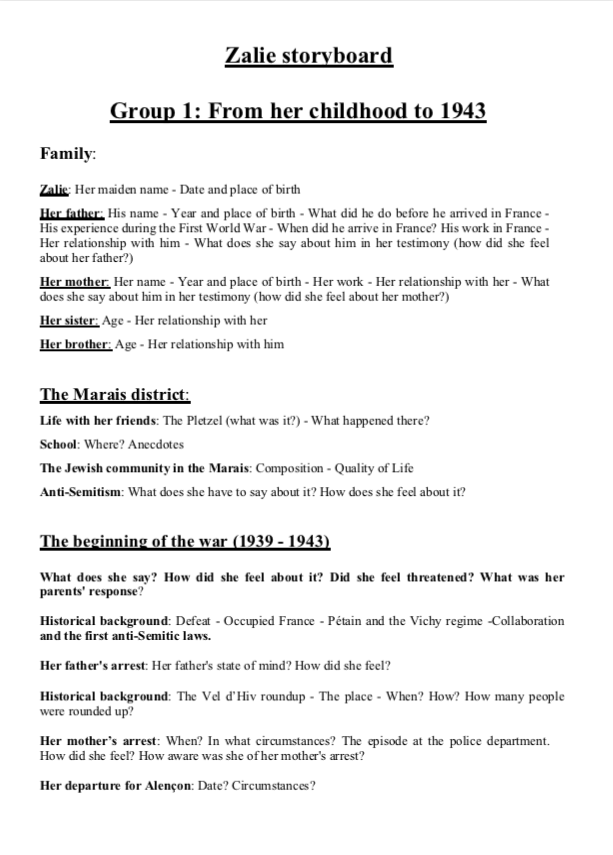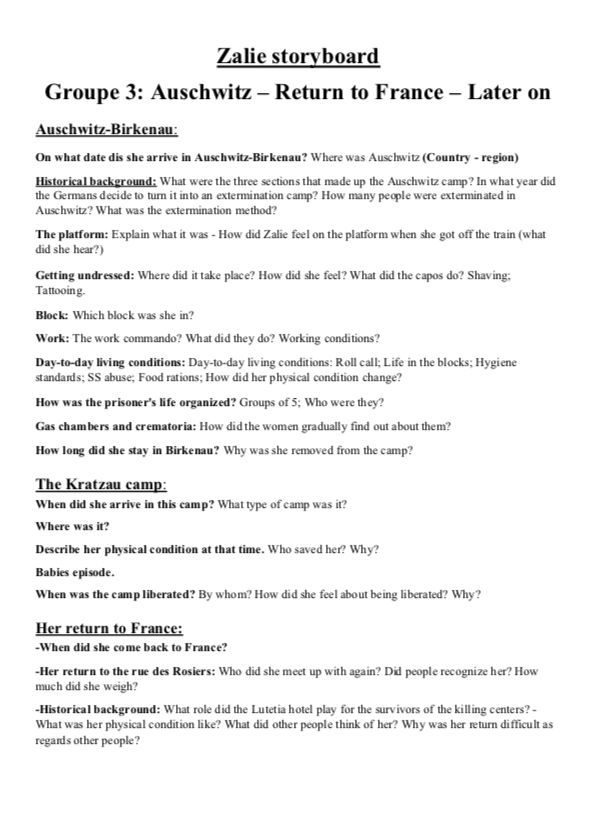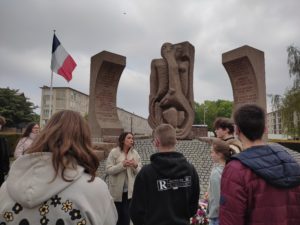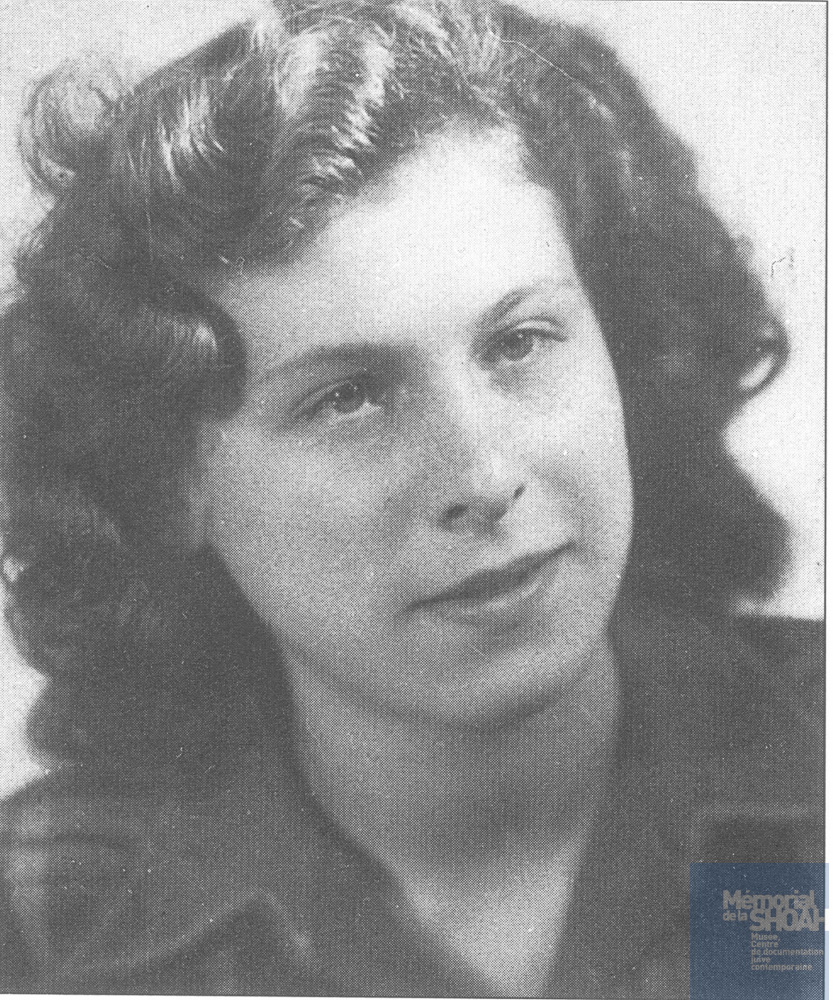Zalie WALDHORN
Creation of a documentary series entitled “Zalie”, which retraces the life of Zalie Hoppen Waldhorn, who was deported on Convoy 77.
The 11th-12th grade students from the Laboratory Quality Control class at the Agricultural high school at the Lemonnier Institute in Caen have made a series in three 3-minute episodes retracing the story of Zalie Glowinski, née Hoppen Waldhorn, who was deported on Convoy 77. This project was carried out in collaboration with a professional videographer, Redha Djafer, from Greenway-video.
Zalie Glowinski was born on January 31, 1927.
She lived at 25 rue des Rosiers in the Marais district of Paris, together with her parents and her brother and sister. After her father was arrested in 1942, followed by her mother in 1943, neither of whom she would ever see again, she headed for Alençon, in Normandy, where she joined the Libenord resistance network.
She was arrested by the Gestapo on January 24, 1944 and transferred to Drancy on July 22, 1944. She was then deported to Auschwitz-Birkenau on July 31, 1944. In November 1944, suffering from typhus, she was sent to the Kratzau camp in Czechoslovakia. After the camp was liberated by the Russians on May 9, 1945, she returned little by little to Paris, where she was reunited with her sister and younger brother.
Over an 18-month period, 11th and 12th grade students in the Laboratory Quality Control program at the Lemonnier Institute agricultural high school in Caen worked on the creation of a documentary series, in collaboration with a Caen-based videographer, Redha Djafer of Greenway Production.
Episode 1:
Episode 2 :
Episode 3 :
This also led to the production of a 3-episode radio series entitled “Passeurs de Mémoires” (Passers-on of Memories) which was broadcast on March 22, 2022 on the Tou’Caen nonprofit radio station. Here are the three episodes:
Episode 1 :
Episode 2 :
Episode 3 :
Approach to the project:
From September to October 2021, the 11th grade Laboratory Quality Control students worked on the background of the Second World War and the Holocaust. In this context, they took part in various educational activities at the Caen Memorial, which introduced them to working with archives.


Visit and educational workshop – Caen Memorial, September 2021
In October 2021, the project was selected by the Normandy regional authority and the Shoah Memorial in Paris as part of the “Study Trip to Auschwitz” program. Due to the Covid epidemic and the resulting geopolitical context, the trip to Auschwitz, which was initially scheduled for January 2022, had to be cancelled and replaced by a study trip to Berlin in May 2022.
From November to December 2021, the students worked with Alain Alexandra and Julia Quellien at the Victims of Contemporary Conflicts Archives Division of the Ministry of Defense Historical Service in Caen on the records relating to Zalie von Hoppen Waldhorn, Mickaël von Hoppen Waldhorn, and Rosa and Hélène von Hoppen Waldhorn. They also took photos of the archives that would later be chosen for inclusion in the documentary. During this period, the students also worked on Zalie’s video testimony for the USC Shoah Foundation, recorded in November1993.



Testimony of Zalie Glowinski (née Hoppen Waldhorn) – USC Shoah Foundation – Nov 1993

In December 2022, the students were invited by the Normandy regional authority and the Shoah Memorial in Paris to attend Ginette Kolinka’s testimony at the Caen Memorial. Some of our students were interviewed by the French newspaper Ouest-France.
Starting in January 2022, the students split into 3 groups and began to write their text, retracing Zalie’s life story for the March 2022 radio show and the recording of the voice-overs for the documentary.
- Group 1 : From her childhood to 1943.
- Group 2 : From Alençon to Drancy.
- Group 3 : Auschwitz – Return to France – After the war.
The students worked from outlines of each part of the story, as follows :



In Mars 2022, the students recorded their radio series (in only one take due to time constraints). The show was aired on March 22, 2022 as part of the French anti-discrimination week.

Recording of the radio series – March 2022

27 rue des Rosiers, in the 4th district of Paris, where Zalie lived as a child
In April 2022, the students went on a guided tour of the Marais district in Paris, in order to learn about Zalie’s childhood and to take pictures of the places where she lived and played with her friends (27 rue des Rosiers, the Hospitalières-Saint-Gervais elementary school and Le Pletzl.

Tour of the Marais, 4th district of Paris – April 2022
The students also visited the memorial museum at the site of the Drancy camp, where Zalie was interned and from which she was deported on Convoy 77 on July 31, 1944. The purpose of the visit was to prepare the text of the voice-over and to take photos to be used in the documentary.

Visit to Drancy camp – April 2022
During their visit to Paris, the students met Zalie’s daughter, Roselyne Glowinski, and had the opportunity to talk with her. Roselyne showed the students the family photos they had previously chosen.

Meeting with Roselyne Glowinski – Place des Vosges – Paris – April 2022

Brandenburg Gate – Berlin – May 2022
In May 2022, the students went on a study trip to Berlin, organized by the Normandy regional authority.

Visit to the Memorial to the Murdered Jews of Europe – Berlin – Mai 2022

Family photo kindly provided by Roselyne Glowinski – Roselyne and her father, Henri Glowinski
At the end of May 2022, the students, working in groups, designed the storyboard for their series. They were asked to choose photos taken during their various field trips, photos from the archives and photos that Roselyne had given them. This work was carried out with the help of Redha Djafer, a videographer from Greenway Video in Caen, who supported them during the entire project.

Family photo kindly provided by Roselyne Glowinski – Zalie, Henri Glowinski, known as “Glou Glou”, and Roselyne

The students working with Redha Djafer of Greenway Vidéo – Designing the storyboard
September 2022, the students summarized their text and worked on the synchronization of the images (photos and archives) and the text. Redha Djafer, the videographer, then recorded the voice-overs for the documentary series.

Recording the voice-overs – September 2022
From October to December, 2022, the videographer, Redha Djafer, edited the series. The format of three 3-minute episodes was intended to be flexible and suitable for use in a lesson plan about the Holocaust for students of varying ages. To this end, we decided to make animated videos. Redha’s task was to synchronize the voice-overs with the images chosen by the students and to set up the animation.
The documentary series was presented on Thursday, January 26, 2023 at the art house cinema “Le Lux” in Caen. The screening was introduced by the students and was attended by 150 students from in and around Caen, along with 20 parents, teachers and project partners:
- Alain Alexandra and Julia Quellien from the Victims of Contemporary Conflicts Archives Division of the Ministry of Defense Historical Service.
- Claire Podetti and Serge Jacubert from the Convoy 77 association.
- Christophe Yvetot from the Normandy regional authority.
- Roselyne Glowinski (Zalie’s daughter), Avriel Huneau (her grandson) and Phyléas Huneau (her great grandson)

Roselyne, Avriel and Phyléas at the screening

The students introducing the project – Thursday January 26, 2023

The students introducing the project – Thursday January 26, 2023

The screening at « Le Lux » art house cinema – Thursday January 26, 2023
Press coverage of the project:
The project was featured in an article in the French newspaper Libération on Friday, January 27, 2023.
“It’s as if she was one of our family”: high school students in Caen researched the life story of Zalie, who was deported to Auschwitz.
Students in their final year of high school in Normandy spent a year researching the life story of a woman who was deported from Drancy to Auschwitz on Convoy 77, with the aim of creating a written and audio biography. An alternative approach to studying the Holocaust.
![]()
12th graders from the Institut Lemonnier high school in Caen have been investigating the life of Zalie Glowinski, an Auschwitz survivor. (Rémy Artiges/Libération)
by Cécile Bourgneuf, published on January 27, 2023 at 7:02 am.
July 31, 1944. As the war was coming to an end, SS officer Alois Brunner was responsible for sending one of the last convoys from Drancy camp to Auschwitz. Aboard Convoy 77 were 1,306 Jewish men, women and children. Only 250 people survived. Zalie Glowinski was one of them.
Nearly eighty years later, the face of this young woman, with wavy hair and a shy smile on her lips, appears on a screen in a classroom at the Institut Lemonnier agricultural high school in Caen, in the Calvados department. The 18 students in the final year of the ” Laboratory and Quality Control ” program are finishing off a painstaking project, which began in September 2021, to retrace the story of “Zalie”. Their history teacher, Thierry Bogacki, had had this idea in mind for a while: “How do I teach my students about the Holocaust in a different way, so that they can immerse themselves in this historical event through a more personal, immediate experience?” He found the solution thanks to the Convoy 77 organization which gives high school students the opportunity to write the biographies of people who were deported on the convoy.
According to poll carried out in 2018 by the Institut français d’opinion publique (French Institute of Public Opinion), more than 20% of 18-24 year-olds say they have never heard of the Holocaust. This is why Georges Mayer, the founder of the association, believes it is important to rethink the way in which the Holocaust is taught: “The idea is to forget the conventional classroom setting in which students are told outright about the six million Jews who were murdered, but rather to offer them a hands-on approach, researching what happened to a deported person who lived near where they live today” explains the son of a Convoy 77 deportee. This helps the students to better remember the history of this conflict “and to participate in an international remembrance project to tell the story of the lives of all these people, the vast majority of whom never returned from the death camps.”. Since the project was launched in 2015, nearly 350 biographies (with another 250 in progress) in English and French have been written by students in some 20 countries where these deported people came from.
:quality(70)/cloudfront-eu-central-1.images.arcpublishing.com/liberation/AZEM7IAGI5CBRAEUAQLEJ3M3DU.jpg)
12th grade students with their teacher, Thierry Bogacki, in Caen, on January 24, 2023. (Rémy Artiges/Libération)
Birth certificates, handwritten letters and arrest records
When they began the project, the students from Caen had only a name to go on: Zalie Glowinski. Many questions had yet to be answered: How old was she when she was deported? Who were her family members? How was she when she came back from the camps? The students began by visiting the Victims of Contemporary Conflicts Archives Division of the Ministry of Defense Historical Service, in Caen. “It was really something to unearth these old, confidential records, because all of a sudden we were stepping into her private life. We put all the pieces of the puzzle together by focusing on each phase of her life,” recalls Clementine, an energetic 17-year-old who has vivid memories of the four hours she spent poring over the official files of Zalie’s entire family. Together with her classmates, Clementine had to sift through birth and death certificates, decipher handwritten letters and arrest and transfer records from Auschwitz to the Chrastava camp (which was in Czechoslovakia at the time), where Zalie caught typhus, as confirmed by a medical report.
Jules moves his fingers as if he were still holding the treasured documents in his hands, saying: “It was as if they were documents from a different era, shrouded in folders. We had lists of the convoys of Jews, written by the Nazis. We had proof of what happened.” The students took photos of the evidence and printed them out. That day, there were sheets of paper scattered all over the classroom tables. The students took photos of the evidence and printed them out. That day the sheets are scattered on the classroom tables. They used them as a foundation for their research, and then listened to the long story that Zalie Glowinski had shared with the USC Shoah Foundation in 1995, an organization founded by Steven Spielberg in the same year, which archives videos of Holocaust survivors’ testimonies. On camera, she speaks about her life for four and a half hours. Her childhood in Paris, her special relationship with her father who felt himself safe in France but was then deported and killed in the gas chambers at Auschwitz, as was her mother. Then her move to Alençon, some sixty miles from the Lemonnier Institute high school, where, still a teenager, she joined the Resistance.
“She only weighed 60 pounds, you could see the outline of her bones”
It was there that she was arrested, before being interned in Drancy camp, and then deported. The students were in tears as they listened to her story. And then they followed her trail: Alençon, Drancy, Paris, where she lived on the rue des Rosiers: “It was strange to see her apartment building and the neighborhood that seemed to have forgotten the Vél d’Hiv roundup.”, said 17-year-old Ethan. The young history enthusiast found “this reconstruction work very interesting” because all the information gathered had to be cross-checked. The students also found out that Zalie was mistaken about a few dates. She had also forgotten going to the Lutetia Hotel in Paris, which had been converted into a reception center for most of the concentration camp survivors. “She only weighed 60 pounds, you could see the outline of her bones. Her neighbors didn’t even recognize her”, says Ines, still affected by the scene that Zalie, who died in 1998, described. Aliénor, meanwhile, could talk about her for hours: “It is she’s one of the family, even though we’ve never met her” the teenager explains.
The students made a radio show based on her biography, which was made into a documentary series at the beginning of 2023 year and shown in a cinema in Caen, attended by Zalie’s daughter and grandson. This made the students proud. “We will most likely teach them more about her”, adds Inès, who became passionate about this project, which she says enabled her “to experience the horror of what happened. By doing this, we will pass on what we have discovered to future generations so that the Holocaust will never be forgotten. We must keep this in mind when we see that there is still a war going on in Europe, in Ukraine”. Their documentary, which is already available online, ends with an audio testimony from Zalie who says in a soft voice, “I was very lucky, but I hope it never happens again.”
Cécile Bourgneuf
Journalist – Libération
113 Avenue de Choisy
75013 Paris


 Français
Français Polski
Polski








